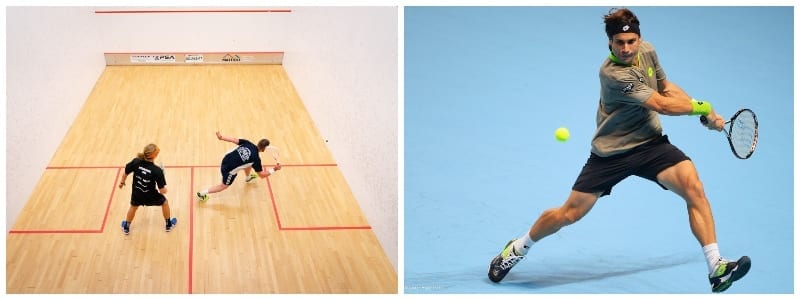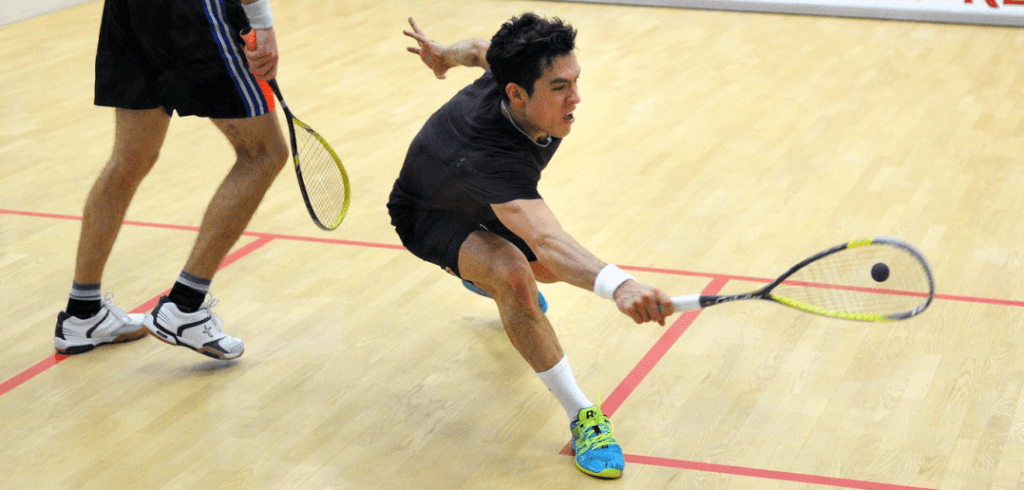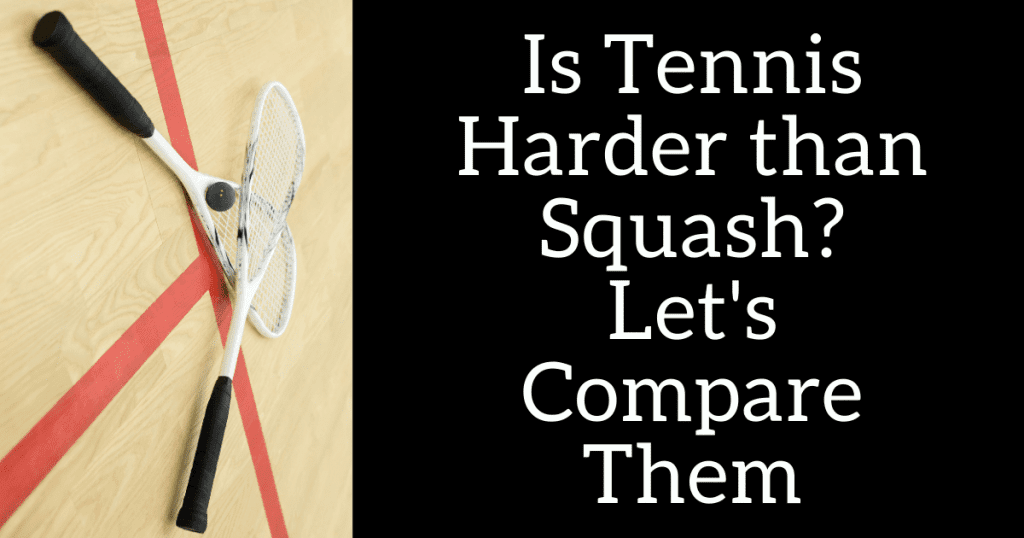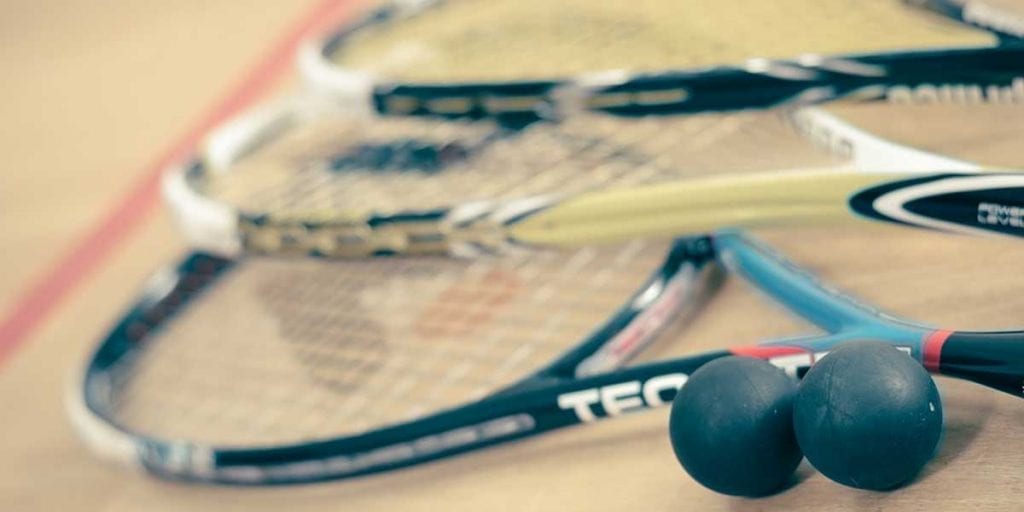Is there a rivalry between the tennis player and squash player in your life? Which racquet sport is superior?
On this site there’s a bias towards tennis, but it’s worth it to take a comparative look at the two racquet sports and figure out the key differences between them.
In this brief overview, we’re going to look at all the ways that they’re different and similar.
If you’ve ever wondered what the deal was with squash versus tennis, you’re about to find out.
Contents
Why is Tennis Harder to Learn Than Squash?

Squash is more about tactics and less about athletic skill (sorry squash players).
The ball doesn’t move as fast as a tennis ball does, the court is smaller, and the athletic requirements at play are reduced.
While there are tactics in tennis, squash more heavily relies on them so you aren’t scooting around the court as much.
Tennis is a more physically taxing and demanding racquet sport.
You can learn tactics from a playbook and get better at squash with some basic athletic skills. With tennis, you’re going to sweat your brains out on the court in order to learn.
Tennis is more of a workout because it takes wider and faster movements to keep the ball in play.
Squash vs Tennis: What are the Stroke Differences?

Tennis strokes occur farther away from the ball.
When playing squash, you’re usually standing very close to the ball when you hit it.
There’s less leaning in and dynamic movements in squash than there is in tennis.
That’s another thing by the way—the smaller court changes how you play the game.
Since you have a shorter arm span on your strokes, more of the tactics comes from stance and positioning.
It still requires athleticism to be able to play squash, just not to the same extent as tennis.
Lookup any video of a squash match versus a tennis match and you’ll see that tennis strokes are more powerful.
What Type of Shots are Used in Squash?

There is more variety of shot making in squash than tennis, but not all shots are required for a good game.
-
Straight Dive
For the most part, this is comparable to your basic forehand in tennis. It’s the most basic squash move and allows you to knock the ball back pretty far. You’re going to approach the ball while sweeping the squash racket upward like with an underhand and lob it at a 45° angle towards the server.
-
Boast
This shot is used when the ball hits a sidewall in the room before hitting the front wall, and you lob it back towards the sender. A boast can be used to fight back against your opponent on the other side of the court. Think of it like there are two separate boast shots, one for offense and one for defense, and you have to make a decision at the moment which one is going to be best.
-
Drop Shot
It’s just as common as a straight dive. You’re going to bend your knees as you stand parallel to the sidewall that the ball is closest to, and swing upward in an arc like you do with a straight drive. These shots are situational, but when you play enough games of squash you’ll find yourself using the drop shot fairly often.
-
Lob
Consider this a love tap to the squash ball. In tennis, lobbing refers to a ball hit very high over the net into the backcourt, but in this instance, it’s very light tap to the ball. A light bounce will send this moving and past your opponent if done properly.
-
Cross-Court Drive
You can hit this one in a variety of ways, but it basically means that you hit it from one end of the court to the other. The goal here is to make sure it can’t be volleyed by your opponent. By using the cross-court drive you’re dragging the game out and making it harder for your opponent to score.
What are the Benefits of Squash Over Tennis?

Squash is arguably a more logical game.
Tennis is about physicality, skill and perseverance. Squash is about being tactical and using your head to figure out a strategy.
Though both racket sports have similar movements, tennis technically requires more athletic skill.
Squash is thought to have a stronger connection to hand-eye coordination and depth perception.
The rubber ball used in squash is smaller than a tennis ball, so you really have to focus to see it while in play.
The dimensions of a squash court are very different than a tennis court. For one thing, walls are used in squash which is more similar to racquetball than tennis.
We love tennis, but we tend to get into a rut every now and then. There’s a wider variety of shot types in squash so that keeps things interesting.
Another benefit is usually the cost.
Tennis has a history of being a rich man’s game (see our history of tennis racquets). Even though it’s more affordable now than ever, you can spend a pretty penny on your tennis racket and shoes alone.
A squash racket is usually a bit cheaper, even when you want top-quality like HEAD or Dunlop.
Is Squash a Good Replacement for Tennis Over Winter Months?

Squash is usually played indoors, so it’s a good replacement for tennis during the winter months if you can’t get outside to play where you live.
While the game of squash has similar elements to tennis, you still have to make a shift to get in the right mindset.
If you switch from tennis to squash every winter (and then back again), you might find that you improve at both sports.
You’re diversifying your overall racket skills.
When you train anything, you get stuck in the habits and movements that everyone else is also using.
Playing squash is a great way to augment your tennis skills with new tactics, movements, and a modified view of how a match could play out.
If for no other reason, squash is good because it keeps a racket in your hand while the courts are frozen over for tennis. Your skills aren’t going to rust through the winter.
You’re still hitting a ball with a racket; it’s just a bit different from what you’re used to.
Diversify Your Game
Squash vs Tennis: which sport wins? Tennis does of course!
Now that you have a quick and comparative viewpoint between both sports, what’s stopping you from diversifying your game a bit?
There’s nothing wrong with hopping on the court for a bit of squash.
Squash has different set of rules and movements to learn. You’ll have a learning curve if you’ve been playing tennis for a while. Trying something a little different is a fun change of pace that can help you with tennis over the long haul.
If nothing else, play a few games and hijack the tactics used in squash to make moves on the tennis court that may shock your opponents.


